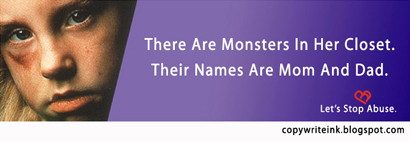Depending on how fast you read this post, about 25 children will be abused, assaulted, or caused severe physical and emotional harm. Many of them by people they trust — their moms, dads, uncles, aunts, brothers, sisters, guardians, teachers, coaches, ministers.
That’s one child, every 11 seconds. One right now.
Those are the obvious cases, statistics and reports chronicled by the National Child Abuse and Neglect Data System (NCANDS), which is a federally sponsored effort that collects and analyzes annual data on child abuse and neglect. One right now. You can find one of the most recent summaries from the U.S. Department of Health & Human Services here.
As defined, these children — one right now — are only counted if the act or failure to act on the part of the parent or caretaker results in death, serious physical or emotional harm, sexual abuse or exploitation (or failure to act, which presents imminent risk of serious harm). That doesn’t count every child — one right now — whose abuse will never be identified, recorded, or reported.
That’s 3.3 million cases reported every year. One right now.
In other words, while newspapers and public opinion might be swayed by these numbers — the real numbers that go unreported, hidden away, and sometimes even blocked by the survivors of abuse are much larger. Equally alarming are those cases that do not even qualify as abuse — one right now.
Somewhere in America, for every one of the approximately 90,000 children who will be sexually abused this year, there will be thousands more who are told they are “worthless,” “lazy,” “ugly,” “bad,” “just like their bum father,” and many other disparaging labels assigned to them by the most trusted source of information — a parent.
One right now.
Parents, in fact, account for more than 90 percent of the perpetrators of abuse, many of whom are ignorant of the outcome that is sometimes spurred on by their own feelings of inadequacy and lack of control. This post won’t change that. But maybe it will help one child, one right now, for some parents to know that how they were raised isn’t the only way. Without any judgment whatsoever, maybe it’s fair to simply point out that their justifications are incorrect. Here are some less obvious forms of abuse.
• Name-calling, putdowns, or assigning statements like “why do you always embarrass me” can work their way into your child’s self-esteem. One right now.
• Discounting major accomplishments because you are too busy on the phone or computer to hear what happened during their day erodes their self-worth.
• Declaring, sharing, and apologizing that you just don’t know why your children are “pigs” is really a form of public humiliation. One right now.
• Threatening body language such as towering above them, raising a hand, or displaying weapons like belts and cooking spoons.
It’s these little injuries delivered sometimes every day — one right now — that shape these children into the people they will become long after the parents’ responsibilities end. Even the best parents might pause now again to ask themselves simple questions: do you spend more time on your commute to work than you do with your child? One right now.
The image above is a reworked billboard from our participation in a campaign for United Way of Southern Nevada several years ago. It caused a lot of controversy because I had only included “dads” as the perpetrators, but it brought attention to where attention was needed.
Of course, even I knew then that while issue ads can be striking, the United Way needed a message that was more apt to raise funds to solve the problem. The following year, we helped them launch their “Great Results Start With U. United Way” campaign that later became “Great results start with you.” It was the longest running, most successful campaign in their history.
I wanted to mention this campaign today because it lends well to the concept of “Bloggers Unite because great results really do start with you. One blogger. One post. One right now. One topic. At a time. One right now.
Please take a moment to read and submit your Bloggers Unite post against abuse to our competition, win $250 for a charity (among other prizes), and receive some well-deserved recognition that will inspire others to lend their voices against abuse; which is important to them. One right now.
You can also purchase a T-shirt with the image above from the Bloggers Unite store. Proceeds from that item this year will be donated to Prevent Child Abuse. Proceeds from other Bloggers Unite items will be donated to aid against animal abuse as requested by our friends at BlogCatalog.
Later today, I will be adding a thank you for all those who came out early to support our "Blog For Hope Post" competition that is underway and BlogCatalog in this very important effort. If you haven't joined this effort today, there is still time. It only takes one.






















